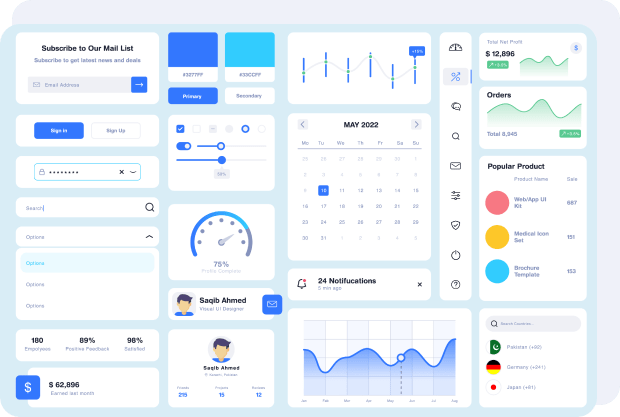Web application development involves creating software applications that operate on remote servers and are delivered to users' devices via the internet. Unlike traditional desktop applications, web apps do not require installation and are accessed through web browsers like Google Chrome, Safari, or Mozilla Firefox. Here are key components and considerations in web application development: Front-end Development: Front-end development focuses on the user interface and user experience (UI/UX) of the web application. It involves using technologies such as HTML (Hypertext Markup Language), CSS (Cascading Style Sheets), and JavaScript. HTML defines the structure of web pages, CSS styles the content, and JavaScript adds interactivity and dynamic behavior to the user interface. Client-side Programming: Client-side programming executes within the user's web browser (client). It handles tasks like rendering content, handling user interactions, and client-side validation. Modern front-end frameworks and libraries like React, Angular, and Vue.js facilitate efficient development and enhanced user interfaces.



Server-side Programming: Server-side programming runs on the web server and manages the backend logic of the web application. It handles tasks such as processing user requests, accessing databases, authentication, and generating dynamic content. Popular server-side languages include JavaScript (Node.js), Python (Django, Flask), Ruby (Ruby on Rails), Java (Spring), and PHP (Laravel).
Database Management: Web applications often use databases to store and retrieve structured data. Relational databases like MySQL, PostgreSQL, and SQL Server are commonly used for structured data, while NoSQL databases like MongoDB and Redis are used for unstructured or semi-structured data.

This includes HTML (HyperText Markup Language), CSS (Cascading Style Sheets), and JavaScript, which are fundamental for creating the structure, style, and interactivity of web pages. Modern frameworks and libraries like React, Angular, and Vue.js enhance development efficiency and user interface capabilities.

Backend development involves programming languages and frameworks such as Node.js, Python (Django, Flask), Ruby (Ruby on Rails), PHP (Laravel, Symfony), and Java (Spring Boot). These technologies handle server-side logic, database interactions, authentication, and data processing.

Web applications often require databases to store and retrieve data. Commonly used databases include MySQL, PostgreSQL, MongoDB (NoSQL), and SQLite. Database management involves designing schemas, optimizing queries, and ensuring data integrity.

APIs enable communication between different software applications. Web applications often integrate with third-party APIs (e.g., payment gateways, social media platforms) to extend functionality or exchange data securely.

Web application security is paramount to protect against vulnerabilities such as SQL injection, cross-site scripting (XSS), and cross-site request forgery (CSRF). Security measures include data encryption, authentication mechanisms, input validation, and regular security audits.

Web applications should be responsive to provide an optimal viewing and interaction experience across a wide range of devices and screen sizes, from desktops to tablets and smartphones.

QA processes ensure the reliability, usability, and performance of web applications. Testing includes functional testing, usability testing, performance testing (load testing, stress testing), and compatibility testing across different browsers and devices.

Deploying web applications involves configuring servers, managing environments (development, staging, production), and automating deployment processes using tools like Docker, Kubernetes, Jenkins, or CI/CD pipelines.

As web traffic grows, ensuring scalability and optimizing performance becomes crucial. Techniques such as caching, load balancing, and efficient resource utilization help maintain responsiveness and handle increased user demand.

Continuous maintenance involves monitoring application performance, addressing bugs and security vulnerabilities, and releasing updates to improve functionality and address user feedback.